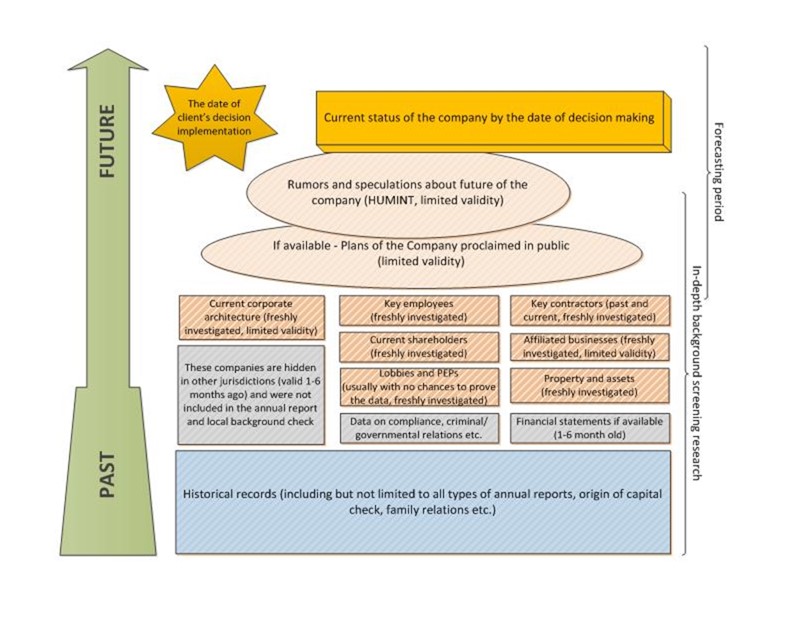Forecasting in Investigations
WHY FORECASTING IS IMPORTANT?
One who had experience of making decisions knows that the decision should be based on information valid and up to date by the moment of decision making and decision implementation.
Let’s imagine that you have to cross the highway. Will you rely on the information provided by the third party that an hour ago there were only 6 cars on the road? I doubt.
Let’s have a look at simple structure of in-depth corporate background screening report.

In general it looks similar to the map of the battle with numerous combat units and the key to understanding of the report is the ability of the analyst (or decision maker himself) to foresee HOW these units will operate and what targets they will try to reach. If we know and understand these targets we will be able to form effective defensive or offensive strategy, else в«Т the job was done for nothing and the client holds in his hands expensive, attractive but useless piece of paper.
First of all, analyzing the case and the raw data we should keep in mind multidimensional table with following rows and columns:
Period of decision making and decision implementation
Usually the client shares his plans and it’s not a problem to identify the period of decision making and decision implementation.
You will be surprised but even reputable companies often leave this question unanswered hoping that the client is smart enough to think for himself. We believe that in fact different procedures should be used for data mining, analyses and forecasting of subject’s activity depending on horizon of decision implementation.
Illustrating the above statement: no reason to keep in mind economic trends if the client plans to make the decision in a week and the agreement with the contractor will be active for 1 month only; on the other side if the client is signing a long-term contract it is reasonable to check if economic, legal, individual (core employees and shareholder) or social changes can effect contract implementation.
Basically we define 4 different horizons of decision making and implementation:
| Short | Middle | Long | Strategic |
| Immediate – up to 1 month | 1 – 6 months | 1-2 years | Constant opposition or partnership |
When we know the answer for the period of decision making we can proceed further and valuate flexibility of the Subject.
Flexibility of the Subject
Every market has its own rules depending on the nature of business, local customs and traditions.
The table below illustrates 4 main groups of Subjects. It is structured in accordance with Subjectв«Єs flexibility and ability to change in a short period of time.
| Very flexible | Flexible | Comparatively inflexible | Inflexible |
| High speed of turnover, informal business structures, seasonal businesses etc. | Small businesses with average speed of turnover, minimum non-current assets: b2b services, IT, distribution, small factories etc. | Businesses with a big share of non-current assets, slow turnover: big producers, factories, constructors, banks, etc. | State business, huge financial institutions, banking networks, international corporations etc. |
The last raw of the table is the list of sources mentioned at the first scheme.
We need to valuate these sources in accordance with the Period of decision making and implementation; Flexibility of the Subject. When it is done, the first target is reached: we know if the data we have should be treated as valuable for the decision maker.
The next step is a forecasting itself which will be described in my next post.


